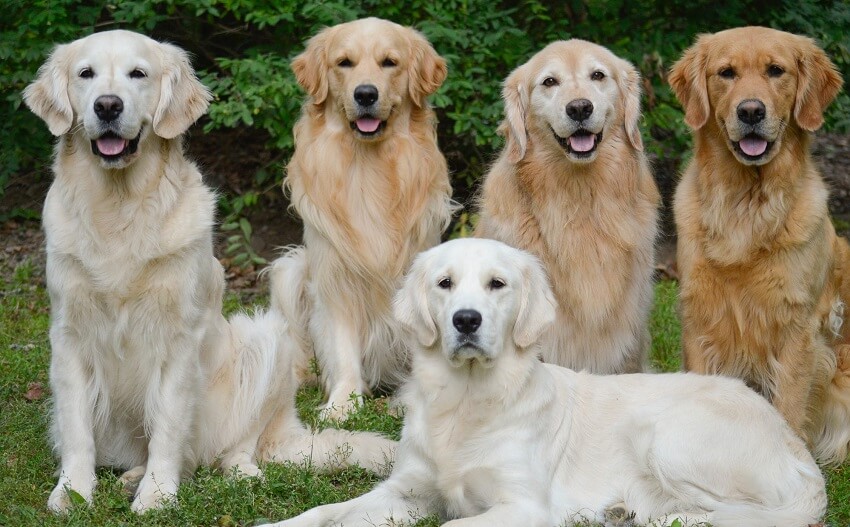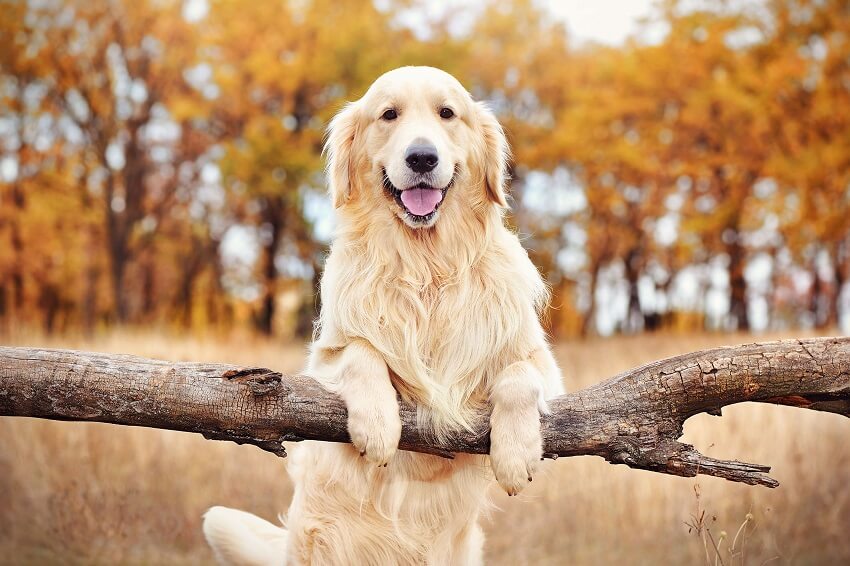Golden Retrievers are quite popular in the US, well-known for their intelligence and agility. But what other traits do Goldens possess beyond these characteristics? Let’s find out. Goldens are a medium-sized breed, very gentle and intelligent. They rank among the most commonly trained dog breeds in America. Join Know All Animals to discover more about the Golden Retriever breed.
1. Understanding the Golden Retriever Breed
The Golden Retriever breed is renowned for its graceful appearance and lovable personality. Let’s delve deeper into the origin, appearance, and temperament of this breed.
1.1. Origin of the Golden Retriever Breed
The Golden Retriever breed originated in the British Isles during the 19th century. This breed was developed by crossing water spaniels and retrieving setters, aiming to create a dog capable of effectively retrieving game without damaging it. The name “Retriever” comes from this breed’s special ability to retrieve prey without harming it.
Initially, Golden Retrievers were developed in Scotland by Lord Tweedmouth, who bred a Yellow Retriever with a Tweed Water Spaniel—a now-extinct breed. He later incorporated other breeds like the Bloodhound and Irish Setter, along with some other hunting dogs, to perfect the characteristics of the Golden breed.
Golden Retrievers quickly gained popularity due to their intelligence, trainability, and excellent adaptability to various environments. Today, Golden Retrievers are kept not only as pets but also participate in many other roles, such as: guide dogs for the visually impaired; therapy dogs for emotional support; and search and rescue dogs or drug detection dogs.

1.2. Common Golden Retriever Coat Colors
Golden Retrievers have a water-resistant outer coat and a thick, soft undercoat. This breed typically comes in two characteristic coat colors: dark yellow and light yellow. Other variations include golden, orange-gold, or cream-gold.
1.3. Physical Characteristics of Golden Retrievers
The Golden Retriever is a breed renowned for its graceful appearance and loyal, friendly temperament. They have a thick, long, double coat with a distinctive golden color ranging from light to dark. Golden Retrievers impress with their large, round, dark brown eyes that convey intelligence and friendliness, along with gently drooping ears that contribute to their gentle and endearing look.
Golden Retrievers are known as intelligent dogs, ranking 4th on Stanley Coren’s list of the world’s most intelligent dog breeds. They have the ability to learn and execute commands after just a few instructions and possess excellent long-term memory. Thanks to this intelligence combined with their gentle and loyal nature, Golden Retrievers are a top choice for roles such as guide dogs, rescue dogs, and therapy support dogs.
Overall, their appearance is quite striking and attracts everyone’s attention. The standard size for an adult Golden Retriever is:
- Females: 55-57cm (21.5-22.5 inches) tall, 27-32kg (60-70 lbs) in weight.
- Males: 58-61cm (23-24 inches) tall, 29-34kg (64-75 lbs) in weight.
This breed has an exceptionally keen sense of smell, which is why they are used for hunting trips and tracking by police. Furthermore, they also make excellent guide dogs.

1.4. Temperament
Goldens are highly intelligent, loyal, obedient, and love outdoor activities. Notably, this breed can even become a nanny for children.
Golden Retrievers love to please their owners. This is why they are willing to do many tasks just to bond and make their owners happy. Goldens are very loyal, obedient, and humorous. They will observe their owners and strive to please them.
Goldens have plenty of energy and are very active, enjoying all kinds of outdoor activities. If a stranger comes to the house, they will alert their owners by barking.
2. Why Do So Many People Keep Golden Retrievers as House Pets?
Currently, many families in Vietnam choose to keep Golden Retrievers as house pets for the following reasons:
- Friendly and Sociable Nature: Golden Retrievers are renowned for their gentle, loyal, and harmonious nature with family members. They are rarely aggressive, always creating a sense of safety and friendliness for the family.
- Intelligent and Easy to Train: This is one of the most intelligent dog breeds, easily grasping lessons from basic to complex. This makes raising and caring for them much simpler.
- Affectionate and Attached: Golden Retrievers are very loving and devoted to their owners. They enjoy being close and playing, bringing joy and warmth to everyone in the home.
- Excellent Adaptability: With their flexible adaptability, Golden Retrievers can live both indoors and outdoors. However, they do require regular exercise.
- Suitable for Many Roles: Beyond being pets, Golden Retrievers are also raised to provide emotional therapy support, guide the visually impaired, or act as companion dogs for the elderly.
The combination of their adorable appearance, wonderful temperament, and high adaptability makes the Golden Retriever one of the most beloved breeds for family pets.

3. How to Raise and Care for a Golden Retriever for New Owners
3.1. Nutrition
First, let’s talk about the nutrition for your Golden Retriever. A proper diet not only helps Goldens grow up healthy but also contributes to extending their lifespan and improving their quality of life. To ensure this, you need to establish an appropriate feeding regimen for each stage:
- Puppy Stage (0–6 months): This is a period of rapid bone and muscle development for Golden puppies, so it’s essential to provide food rich in protein and calcium. Meals should be divided into 4–5 small portions per day for easy digestion and absorption.
- Adult Stage (6 months and older): As your dog matures, the number of meals can be reduced to 2–3 times per day. Their diet should be balanced in all nutritional groups, including protein from meat and fish; fiber from vegetables; and healthy fats from fish oil, to maintain their health and energy.
- Foods to Avoid: To ensure your dog’s safety, absolutely do not feed them sweets, small bones, chocolate, or foods containing onions and garlic, as these can cause severe harm to their health.
3.2. Health Care
To keep your Golden Retriever healthy and thriving, consistent attention to their health is crucial. First, you should ensure they receive all essential vaccinations, such as the 5-in-1, 7-in-1, and rabies vaccines, to protect them from dangerous infectious diseases. Additionally, make sure to perform regular deworming to eliminate parasites and ensure their digestive system functions well.
Moreover, you should also take your dog to the vet for regular health check-ups. This helps detect any potential issues early and maintain their overall health. Proper care not only extends their lifespan but also enhances the quality of life for your Golden Retriever.
3.3. Coat and Skin Care
Golden Retrievers have a thick, soft, and silky coat, so proper coat care is vital to keep them clean and healthy. You should brush your Golden’s coat at least 2–3 times a week to remove loose hair, minimize tangles, and maintain its natural softness and sheen.
Additionally, bathing your dog regularly, 3–4 times a month, using a specialized dog shampoo will help cleanse their coat and skin while effectively preventing skin irritation. Proper coat care not only ensures your Golden’s beauty but also helps them feel more comfortable and healthier.
3.4. Exercise Regimen
Golden Retrievers are an energetic breed, so regular exercise is a crucial factor in maintaining their health, preventing obesity, and expelling excess energy. You should dedicate 30–60 minutes each day to physical activities such as walking your dog, playing fetch, or jogging. These activities not only keep your dog physically healthy but also strengthen the bond between you and them.
Besides physical exercise, Golden Retrievers also need mental stimulation for holistic development. Using toys like balls, puzzle toys, or faux bones will help train their cognitive abilities and keep them engaged. An appropriate exercise and entertainment regimen will ensure your dog remains healthy, happy, and full of energy.

4. Common Health Issues Golden Retrievers Are Prone To
Like many other dog breeds, Golden Retrievers are susceptible to several common diseases, especially those that are genetic or related to their physical characteristics. Here are some frequently observed conditions in this breed:
- Hip Dysplasia: This is a common condition in large breeds, causing difficulty and pain when moving. To prevent it, avoid strenuous exercise when your dog is young and maintain an appropriate weight to reduce stress on their joints.
- Obesity: With their natural love for food, Goldens are very prone to obesity if their diet isn’t controlled or if they lack sufficient exercise. The solution is to establish a balanced and appropriate diet and ensure your dog gets regular training and physical activity.
- Cardiovascular Diseases: Some individual Goldens may suffer from congenital heart conditions or develop heart problems in old age. To minimize risks, you should take your dog for regular health check-ups, monitor for unusual symptoms, and seek timely treatment if a disease is detected.
- Ear Infections: Due to their floppy ears, Goldens are prone to dust and bacteria accumulation inside their ears, leading to a risk of ear infections. To prevent this, regular ear cleaning, careful hygiene, and frequent ear health checks are necessary.
5. How much does a Golden Retriever cost?
In the United States, the price of a Golden Retriever typically ranges from $1,500 to $2,000, depending on the breeder and location. In some cases, prices can be higher, especially for dogs with certified pedigrees and clear purebred documentation, potentially reaching up to $2,500.
The Golden Retriever is not just a lovable dog; it’s also an ideal companion thanks to its intelligence, loyalty, and ease of care. Whether you live in the city or the countryside, a Golden will always bring joy, connection, and become an indispensable member of your family. If you’re looking for an amiable, friendly, and easy-to-train dog, the Golden Retriever will certainly be an excellent choice.
FAQs About Golden Retrievers
1. Are Golden Retrievers good for first-time dog owners?
Yes. Golden Retrievers are known for their friendly, obedient, and intelligent nature. They are easy to train, gentle with kids, and adapt well to family life — making them ideal for beginners.
2. Do Golden Retrievers shed a lot?
Yes, they shed year-round, especially during spring and fall. Regular brushing (2–3 times a week) helps control shedding and keeps their coat healthy.
3. How much exercise does a Golden Retriever need daily?
Around 1 to 2 hours per day. They are active dogs and need daily walks, playtime, or training sessions to stay physically and mentally healthy.
References: https://en.wikipedia.org/wiki/Golden_Retriever



